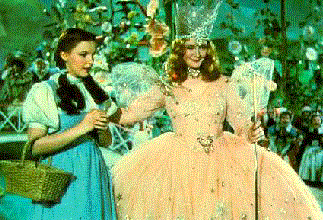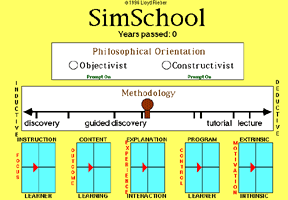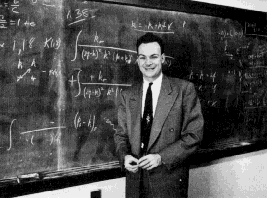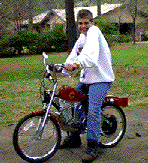1
Lloyd Rieber
Editor’s Note: In 1998, Rieber was invited to give the 1998 Peter Dean Lecture for AECT and later published his remarks on Rieber’s own website. It is republished here by permission of the author.
Rieber, L. (1998). The proper way to become an instructional technologist. Retrieved from http://lrieber.coe.uga.edu/pdean/
Prologue
I wrote this essay to support my Peter Dean Lecture at the 1998 AECT convention. The invitation to present this lecture came only several weeks before the scheduled presentation at AECT. Consequently, there was little time to put these ideas into written form for the ITFORUM discussion that traditionally follows this lecture. Interestingly, though the lecture and discussion have long past, I have not felt it necessary to revise the essay. Despite the fact that it lacks the “scholarship polish” of a refined work, I think it still captures well my thoughts and feelings that I initially struggled to organize and convey. I presented my essay and conducted the ITFORUM discussion in the spirit of sharing some ideas as works in progress. I think this is a style that takes full advantage of electronic media—to offer a set of ideas that lead to more questions than answers and to engage a group of thoughtful people in a discussion of the ideas to tease out what is and is not important.
The purpose of the Peter Dean Lecture, as I understand it, is to choose someone who has been around long enough to appreciate the struggles of the field and to give that person the opportunity to give a critical analysis of where we are and where we might go. This presents a nice opportunity, but a presumptuous one in my opinion, for the person chosen. Are my experiences and points of view a valid cross section of the field? Obviously not. Nevertheless, I used this opportunity to speak to some issues that interest and concern me, in the hope that they might trigger some reflection and comment—I still hope that is the case for those who now happen upon this essay.
Introduction
The inspiration for the topic of my AECT presentation and this essay comes from an article published by Robert Heinich in 1984 called “The Proper Study of Educational Technology.” At the time I first read the article (around 1986), its title rubbed me the wrong way. There was something unduly pretentious about it—that there was, in fact, a proper study of instructional technology (IT). When I first read the article, I must admit that I incorrectly interpreted it. Heinich warned strongly against the “craft” of IT which I wrongly interpreted as “art.” I have long been sensitive to our field disavowing the artistic side of IT and instead overemphasizing, I felt, its scientific aspects. Having just reread the article, I am very impressed with how forward looking Heinich’s thinking was at the time, especially regarding the role of research. The purpose of this essay, therefore, is not to take issue with Heinich’s ideas, but to use them to motivate another question: What is the proper way to become an instructional technologist?
 Many would quickly argue that the proper way is to go to a university and get a degree in IT. This reminds me of the scene from the Wizard of Oz in which the wizard tells the scarecrow that he has as much brains as anyone else, but what he needs is a diploma to prove it. (L. Frank Baum was no stranger to sarcasm.) Of course, there is definitely a formal side to getting an education in our profession, but I believe that the best of our field have learned that our theories and models must be grounded in the actual context of the problem. More about this later. I have also long been struck by the many paths taken by people who now find themselves called instructional technologists. Our profession consists of individuals with an amazing diversity of backgrounds, goals, and education. It is also common for many people to say they didn’t even know the field existed until they were already a practicing member of it.
Many would quickly argue that the proper way is to go to a university and get a degree in IT. This reminds me of the scene from the Wizard of Oz in which the wizard tells the scarecrow that he has as much brains as anyone else, but what he needs is a diploma to prove it. (L. Frank Baum was no stranger to sarcasm.) Of course, there is definitely a formal side to getting an education in our profession, but I believe that the best of our field have learned that our theories and models must be grounded in the actual context of the problem. More about this later. I have also long been struck by the many paths taken by people who now find themselves called instructional technologists. Our profession consists of individuals with an amazing diversity of backgrounds, goals, and education. It is also common for many people to say they didn’t even know the field existed until they were already a practicing member of it.
Take my background, for example. I started off my undergraduate education as an engineering student. In the summer of my freshman year, I traveled in Latin America working with several youth groups. The experience convinced me that I didn’t want to become an engineer, but instead I wanted to know more about the complexity of people and their cultures. I took several paths from there, at one point actually completing the paperwork to declare a major in anthropology. I came to the education field most unexpectantly. I eventually became an elementary school teacher—trained in a large urban university in the northeast of the USA, but got my first job in a very small rural school in the American Southwest (New Mexico). This was 1980 which, coincidentally, was about the time that desktop computers were introduced into mainstream education. I found myself thrust into a position where technology, education, and different cultures were rapidly mixing.
In a lot of ways, this was perfect position for a person like me. There were few formal ideas in force about how to use computers in education (at least in my district) and the school administration actually encouraged “early adopters” such as myself to explore different ideas and take some risks. I later discovered, when I entered graduate school, that many of the things I had learned on my own in those years about technology, instructional design, and learning theory actually had formal names in the literature (one example is the concept of rapid prototyping).
Elementary school teachers are, as a group, very sensitive to the student point of view (though don’t take this as an insult to other groups). It’s just that the complexity of domains (e.g. math, science, language arts, etc.) is not as demanding to the adult as they are to the student. Consequently, the adult teacher is somewhat freed from the demands of the content, but forced to consider what it must be like for a 10 year old to learn something like fractions. Most elementary school teachers are also faced with teaching a broad array of subjects, so the concept of integrating subjects in meaningful ways is familiar to us. (Heck, I also taught music—the elementary school was one of the few places where my accordion was truly appreciated!) My education to become a teacher was heavily rooted in Piagetian learning theory, so it is easy to see how I came to use LOGO with students and to understand the facilitative role it demanded of teachers. In hindsight, I can’t think of a better place than the elementary school classroom for me to have received my first education as an Instructional Technologist. (“Holmes, my good man, what school did you attend to become an Instructional Technologist?” “Elementary, my dear Watson, elementary.”) I wonder how many of you have backgrounds exactly like mine. Few, I wager. So, while studying engineering and culture, traveling, followed by being an elementary classroom teacher in a context where technology was introduced with no training was the proper way for me to become an instructional technologist, I know it is a path not to be exactly duplicated by anyone.
Instructional Technologist As Computer Scientist
Heinich’s article discusses the frustration of IT being considered a service arm of education. Our role, to many people outside the field, is to “connect the pipes” and to fix the machines. The advent, growth, and semi-dependency of education on computing has reinforced this position in many ways. Let’s face it, most people outside our field equate us—and respect us—for our mastery of technologies such as the computer. So, perhaps the proper way to become an instructional technologist is first to become a computer wizard, that is, to master the tools first and to assume that the knowledge of how to apply the tool in education will come merely as a consequence. However, I like to point out that “A power saw does not a carpenter make.” Owning a power saw coupled even with the knowledge of how to use it safely to cut wood does not make one a carpenter. For example, consider the contrast between two carpenters who appear on American public television shows—Roy Underhill and Norm Abrams. For those of you not familiar with these two, Roy appears on The Woodwright’s Shop, a show dedicated to preserving carpentry skills practiced before the advent of electricity. In contrast, Norm Abrams, a self-professed power tool “junkee,” appears in This Old House and The New Yankee Workshop. Despite their different approaches and attitudes to the use of technology, I’m quite sure that both would thoroughly enjoy the other’s company and wile away the hours discussing what they both love best, namely, carpentry. However, despite my respect for Roy’s skills and philosophy, when I try my hand at even mid-size woodworking projects, such as building a patio deck or storage shed, you can bet that I prefer to use the power tools available to me. Likewise, in education, I prefer to take advantage of the opportunities that the available “power tools” afford, such as the computer. But underlying it all, is a profound core of, and respect for, the essential skills, strategies, and experiences akin to those possessed by the master carpenter.
Instructional Technologist As Philosopher
Has anyone else noticed how much of our literature in recent years has been devoted to philosophy? So, perhaps the proper way to become an instructional technologist is to become a philosopher and first unravel the mysteries of what it means to “be” and what it means to “know.” The field seems quite preoccupied with uncovering if there is a “real” world or whether reality exists solely in the mind of the individual. I have come to the conclusion that Instructional Technologists are not well equipped to handle philosophical problems such as these and question if it is a good use of our time.
The debate between objectivism vs. constructivism, though a healthy and necessary one, has also had the tendency for people to believe that there is a “right answer” to what their philosophy “should be.” It’s almost as though they were taking some sort of test that they need to pass. I suppose most just want to be associated with the dominant paradigm instead of digging down deep to better understand their own values, beliefs, and biases. I’ve also noticed it is in vogue to question others about their philosophical camp, not in order to enter into a dialogue of how one’s philosophy informs one’s design, but more to sort people in a convenient manner. (This resembles to me how Dorothy was questioned by Glinda: “Are you a good witch or a bad witch?” The answer, of course is “Why, I’m not a witch at all.”)

Don’t mistake my meaning. I believe strongly in each professional developing a strong philosophical stance (I myself have tried to do so in several places, such as Rieber, 1993). It’s just that we have tried, at times, to misapply the business of philosophy or to try to tackle philosophical questions that have remained unresolved for thousands of years. There are productive uses for philosophy in our field, but there is the danger of sliding into philosophical quagmires, or worse, trying to use philosophical positions to inappropriately judge people. (Click here for an example of a little exercise I like to use in some of my classes that gets at the importance of considering one’s philosophical points of view.)
Not being a philosopher, I have found it difficult to effectively raise and lead discussions on philosophical issues in my classes. I had always joked about wanting some sort of simulation that embedded these issues in a way that one could “experience” them rather than just talk about them. You know, something like ‘SimCity’ or ‘SimLife.’ Wouldn’t it be great, I thought, to also have a similar simulation to help one play with these complicated issues as well as understand what the educational system would be like 50 or 100 years from now if a major paradigm shift really took place today! Ha ha, it was a quaint inside joke. Well, one day I decided to put a working prototype of ‘SimSchool’ together for my next class. I have “shocked” Simschool and offer it here for you to try out (of course, you will first need access to the web, have enough RAM, and be able to download and install the right plug-in from Macromedia, etc.). If you do take a look, don’t take it too seriously. This simulation has not been validated. It is just a little exercise to get my students to “try out” the philosophical implications on education, from my point of view. What is most useful is when people take issue with my interpretation and instead put forward how THEY would design SimSchool. These are the discussions that really matter.

Instructional Technologist As Physicist Or Mathematician
Perhaps the proper way to become an instructional technologist is to first become a physicist or mathematician. Many of the leading scholars in the field began this way. Seymour Papert is a mathematician by training, Alfred Bork is a physicist. Sometimes I wonder if our field suffers from “physics envy”—we want desperately, it seems, to be considered a science. Well, I actually enjoy reading about theoretical physics (at least as far I can without knowing the mathematics).
One physicist I have become fascinated with is the late Nobel laureate, Richard Feynman. Some of you might know him due to his role on the committee investigating the Space Shuttle Challenger disaster. (My daughter was in first grade at the time. The whole school was gathered in the school’s cafeteria to watch the lift-off. I recall my daughter coming home after school telling us that it was her job to go find the principal to tell her that the “shuttle blew up.”) I have become interested in Feynman for lots of reasons, but of relevancy here was his apparent genuine concern about his teaching. While other physicists and mathematicians-turned-educators often come across to me thinking they know all the answers to the problems of education—I’m not saying Papert and Bork are like this ;)—Feynman remained quite reflective (not to mention baffled) by the entire teaching/learning process. In the preface to The Feynman Lectures, a set of well-known readings to introductory physics, Feynman expressed his frustration in not being able to meet the needs of students known not to be the brightest or most motivated (in other words, those like me). Rather than just blame the students, he publicly took his share of the responsibility.

I also liked the way Feynman talked about his teaching in a very reflective, almost constructivistic way. That is, he seemed to understand that teaching was a way for him to understand problems in new and important ways. He once wrote about turning down the opportunity to go and work at Princeton at the Institute for Advanced Study BECAUSE he would not have to teach. Here is an excerpt (go to http://www.math.utah.edu/~alfeld/feynman.html for the complete quote):
I don’t believe I can really do without teaching. . . . If you’re teaching a class, you can think about the elementary things that you know every well. These things are kind of fun and delightful. It doesn’t do any harm to think them over again. Is there a better way to present them? The elementary things are easy to think about; if you can’t think of a new thought, no harm done; what you thought about it before is good enough for the class. If you do think of something new, you’re rather pleased that you have a new way of looking at it. The questions of the students are often the source of new research. They often ask profound questions that I’ve thought about at times and then given up on, so to speak, for a while. It wouldn’t do me any harm to think about them again and see if I can go any further now. The students may not be able to see the thing I want to answer, or the subtleties I want to think about, but they remind me of a problem by asking questions in the neighborhood of that problem. It’s not so easy to remind yourself of these things. So I find that teaching and the students keep life going, and I would never accept any position in which somebody has invented a happy situation for me where I don’t have to teach. Never.
While I don’t know how much his students may have learned, his willingness to admit how vital teaching was to his own professional development is refreshingly straightforward.
Instructional Technologist As A Graduate Of An Instructional Technologist Program
I finally come to the time honored tradition of going to a university and getting a degree. The diploma becomes one’s “membership card” with all the rights and privileges therein to participate as a member of the profession (though it does not, of course, guarantee a job!). I feel I must tread lightly here so as not to be misinterpreted, especially considering I am a member of a university’s faculty. Nevertheless, I have long been frustrated with the way in which instructional technologists are educated at universities (notice my deliberate avoidance of the term “train”). There are many areas to be considered here, so I will only focus on one in any depth: The congruency between instructional design as written and taught, and how it is actually done in practice. Related to this is the role played by theory and research in guiding, or even informing, practice.
One of the most problematic relationships in our field is that which exists between theory, research, and practice. The problem is shared by professors, researchers, students, and practitioners alike. That is, a professor who is unable (or unwilling) to connect theory with practice is just as guilty as a student who avoids confronting or demeans theoretical implications of practice. The textbooks make the relationship seem so clear and straightforward, yet my experience with actually doing instructional design has been messy and very idiosyncratic. Michael Streibel (1991, p. 12) well articulated what I had felt as I tried to reconcile instructional design as it was written and talked about versus how I had actually done it:
I first encountered the problematic relationship between plans and situated actions when, after years of trying to follow Gagné’s theory of instructional design, I repeatedly found myself, as an instructional designer, making ad hoc decisions throughout the design and development process. At first, I attributed this discrepancy to my own inexperience as an instructional designer. Later, when I became more experienced, I attributed it to the incompleteness of instructional design theories. Theories were, after all, only robust and mature at the end of a long developmental process, and instructional design theories had a very short history. Lately, however, I have begun to believe that the discrepancy between instructional design theories and instructional design practice will never be resolved because instructional design practice will always be a form of situated activity (i.e. depend on the specific, concrete, and unique circumstances of the project I am working on).
 This idea that instructional design is largely contextual and relies so heavily on creative people working with unique problems resonates with me even more due to my experience of being the parent of a child with special needs. My son Thomas has mental retardation as well as a wide array of other problems, including language and behavior disorders (the term “pervasive developmental disorder” is used to vaguely characterize the diversity of the disability). There is a not so great movie titled “Dog of Flanders” involving a poor Dutch boy who desires to become a painter. One day he visits the studio of a master painter and is shocked to learn that this painter sometimes uses a knife to paint with. In response, the painter responds matter of factly that “I would use my teeth if I thought it would help.” There have been countless times I have felt the same thing about how I might improve my teaching or instructional design, despite of what I think I know about learning theory, etc.—I, too, would do just about anything if I thought it would help. My work with my son points to situations where the distinction between cognitive/behavioral or objectivistic/constructivistic becomes quite gray and rather unimportant. Click here to play a shocked version of a simple game called “Super Hero”. I like to say that I designed this game with Thomas, not for Thomas. He has contributed to its construction in so many ways that I feel he deserves to be called a “co-designer.” I think this notion is useful to any designer. Work with end users to such an extent that you feel you owe them co-ownership of what you design.
This idea that instructional design is largely contextual and relies so heavily on creative people working with unique problems resonates with me even more due to my experience of being the parent of a child with special needs. My son Thomas has mental retardation as well as a wide array of other problems, including language and behavior disorders (the term “pervasive developmental disorder” is used to vaguely characterize the diversity of the disability). There is a not so great movie titled “Dog of Flanders” involving a poor Dutch boy who desires to become a painter. One day he visits the studio of a master painter and is shocked to learn that this painter sometimes uses a knife to paint with. In response, the painter responds matter of factly that “I would use my teeth if I thought it would help.” There have been countless times I have felt the same thing about how I might improve my teaching or instructional design, despite of what I think I know about learning theory, etc.—I, too, would do just about anything if I thought it would help. My work with my son points to situations where the distinction between cognitive/behavioral or objectivistic/constructivistic becomes quite gray and rather unimportant. Click here to play a shocked version of a simple game called “Super Hero”. I like to say that I designed this game with Thomas, not for Thomas. He has contributed to its construction in so many ways that I feel he deserves to be called a “co-designer.” I think this notion is useful to any designer. Work with end users to such an extent that you feel you owe them co-ownership of what you design.
My current interest in play theory is also an example of my struggle with how our field characterizes the interplay between research, theory, and practice. On one hand, my interest in play is derived by working with children and watching the intensity with which they engage in activities they perceive to be worthwhile. However, I also wanted to explain more thoroughly my own experiences of being so involved in activities that nothing else seemed to matter. My curiosity led me to themes I had first encountered when I was a “short lived” student of anthropology, namely games and their cultural significance. I also found out about Flow theory and saw how well it described the play phenomena.
I have come to see the story of the Wright Brothers’ invention of the airplane as a good metaphor for understanding the proper relationship between theory, research, and practice in our field (it is even a good metaphor if you live in a country that takes issue with them getting credit for being declared the first to invent the airplane!). That the Wright Brothers were technologists, inventors, and tinkerers is not questioned, but people do not realize that they were also scientists who asked the right questions about the theory of the day and crafted ingenious experiments to get at the answers. Most of all, people forget that they were also the world’s most experienced pilots at the time. They took their findings into the field and practiced what they studied. These experiences likewise informed their scientific side of the enterprise, culminating in a controllable aircraft. (Incidentally, it’s the “controllable” part of the invention that is the real genius of the brothers.)
In broaching the subject of the adequacy of graduate programs in preparing people to become instructional technologists, I hope I do not unleash the floodgate of individual criticisms or personal war stories. Instead, I wish us to look more broadly at the aims and goals of graduate programs as compared to what is needed or actually done in the field. For example, I think the distinction between education and training is useful here. I can’t name one technical skill I learned in a graduate course that I still use exactly as taught. Instead, all of the technical skills I now use were learned either on my own, through professional development, or by preparing to teach others (mostly the latter). In my opinion, universities are not supposed to prepare technicians to perform a specific job, but rather should prepare people for a life’s study. It is fair to ask how well we, at the University of Georgia, are doing. To our credit, I will tell you that our faculty has openly discussed among ourselves and with students what we are doing and whether there is a better way. I am proud to report that we will be trying a new approach at the Master’s level that we are referring to as a “studio-based approach.” We are also quite nervous about it because it represents an approach with which none of us have much experience. However, we all seem to agree that it will be an approach more closely (and honestly) aligned with our beliefs about how people learn and what people need.
Many issues on this topic remain, such as the proper role of research. (I see at least two, by the way. One is the traditional role of research contributing to the literature. A second role for research, though less recognized, is how it informs the researcher. The act of doing research becomes a source of ideas and invention, leading to a much deeper conceptual understanding of the topic or problem being studied. Even if the research itself goes wrong in some way, the researcher grows intellectually and emotionally from the experience. I’m not sure how to characterize this research purpose since it does not fit any traditional category (e.g. basic, applied, etc.), so perhaps we should just call it “constructive or reflective research.”) Another topic worth pursuing is the way universities assess student achievement. This is not an indictment of testing per se, but I admit I find it strange that we still assign letter grades in most of our graduate courses. (That one should bring in the mail.)
Closing
So, what is the proper way to become an instructional technologist? Obviously, my position is that there is not one way and that we should value the diversity of the people who make up our profession. I also challenge each faculty member and student to stand back from their graduate curricula and question the purpose and relevance of the experiences that are contained there. However, this is all too easy, so I end by offering two lists. The first is one I posted on ITFORUM awhile back. It’s my way of “reverse engineering” what I do in language that people outside the field can understand (such as my parents):
I’m an instructional technologist……
- I help people learn new things.
- I solve problems in education and training, or find people who can.
- I use lots of different tools in my job; some are ‘things’ like computers and video, other tools are ideas, like knowing something about how people learn and principles of design.
- I know a lot about these tools, but I know I have to use them competently and creatively for the task at hand before they will work.
- I consider using all of the resources available to me, though sometimes I have to go and find additional resources.
- I am most interested in helping children, but many of my colleagues work with adults.
- I resist doing things only because “we’ve always done it that way,” but I’m also careful not to fall for fads or gimmicks.
- I always try to take the point of view of the person who is going to be using the stuff I make while I’m making it; that’s really hard, so I get people to try out my stuff as soon as I can to see what I am doing wrong.
- I’m not afraid to say, “Yes, that’s a better way to do it.”
Finally, here is a list of things I feel one needs to do to become, and remain, an instructional technologist and represents, I hope, the best of what we are doing in our graduate programs:
- Do Instructional Technology: Work with people; take a genuine interest in their interests; listen.
- Study the design process, study how people learn individually and collectively, and study media’s role in learning.
- Strive to understand the interdependency of theory, research, and practice.
- Learn the “how’s and what’s” of media.
- Play
I’m sure you can add to this list.
I hope you have been able to follow this roughly written essay. Here are a few questions, offered with the hope that a few of you will consider posting your thoughts to the list:
1. What is your story about how you came to be an instructional technologist? What is unique about it? I am especially curious about individuals who do not hold graduate degrees in instructional technology.
2. How well prepared were you to face the problems you now encounter in your jobs?
3. Those of you who have a formal degree in IT, how satisfied are you as to how well you were prepared to do the job you now have? How well aligned were issues surrounding theory, research, and practice? I know that many non-American programs are not so reliant on course-driven models (and this is part of our redesign), so I am anxious to hear more about them.
4. What would you add to my list of things that characterize what Instructional Technologists actually do, as a profession?
5. What would you add to my list of what one needs to do to adequately prepare to become an Instructional Technologist?
Acknowledgments
I’d like to give Steve Tripp and Ron Zellner some credit for some of the ideas here, since some were derived from some long, enjoyable (and independent) conversations with them over the years.
Application Exercises
- Reflect on your experiences and how they have brought you to the field of instructional design. How are they similar to the paths described in this chapter and how do they provide you with a unique perspective on instructional design?
- Based on your individual goals, and what you understand of the field today, create your own list (see Rieber’s in the “Closing” section) outlining how you envision your role as an Instructional Technologist/Instructional Designer.
References
Csikszentmihalyi, M. (1990). Flow: The psychology of optimal experience. New York: Harper & Row.
Feynman, R., Leighton, R., & Sands, M. (1963). The Feynman Lectures on Physics. Reading, MA: Addison-Wesley.
Heinich, R. (1984). The proper study of instructional technology. Educational Communications and Technology Journal, 32(3), 67–87.
Rieber, L. P. (1993). A pragmatic view of instructional technology. In K. Tobin (Ed.), The practice of constructivism in science education, (pp. 193–212). Washington, DC: AAAS Press.
Rieber, L. P. (1995). Using computer-based microworlds with children with pervasive developmental disorders: An informal case study. Journal of Educational Multimedia and Hypermedia, 4(1), 75–94.
Rieber, L. P. (1996). Seriously considering play: Designing interactive learning environments based on the blending of microworlds, simulations, and games. Educational Technology Research & Development, 44(2), 43–58.
Rieber, L. P., Luke, N., & Smith, J. (1998). Project KID DESIGNER: Constructivism at work through play, : Meridian: Middle School Computer Technology Journal [On-line], 1(1). Available http://www.ncsu.edu/meridian/index.html
Rieber, L. P., Smith, L., & Noah, D. (in press). The value of play. Educational Technology.
Streibel, M. (1991). Instructional plans and situated learning: The challenge of Suchman’s theory of situated action for instructional designers and instructional systems. In Gary Anglin (Ed.),Instructional technology: Past, Present, and Future (pp. 122). Englewood, CO: Libraries Unlimited.
von Glasersfeld, E. (1993). Questions and answers about radical constructivism. In K. Tobin (Ed.), The practice of constructivism in science education, (pp. 23–38). Washington, DC: AAAS Press.
Other Resources
http://www.geocities.com/Hollywood/Hills/6396/witches.htm
 Lloyd Rieber is originally from Pittsburgh Pennsylvania where he was born and raised. He is now a Professor of Learning, Design, and Technology at the University of Georgia. He was once a public school teacher in New Mexico and in 1987 earned his Ph.D. at Penn State. Before going to the University of Georgia, Lloyd spent six years on the faculty at Texas A&M. Lloyd’s research interests include simulations, games, accessibility, microworlds and visualization.
Lloyd Rieber is originally from Pittsburgh Pennsylvania where he was born and raised. He is now a Professor of Learning, Design, and Technology at the University of Georgia. He was once a public school teacher in New Mexico and in 1987 earned his Ph.D. at Penn State. Before going to the University of Georgia, Lloyd spent six years on the faculty at Texas A&M. Lloyd’s research interests include simulations, games, accessibility, microworlds and visualization.
